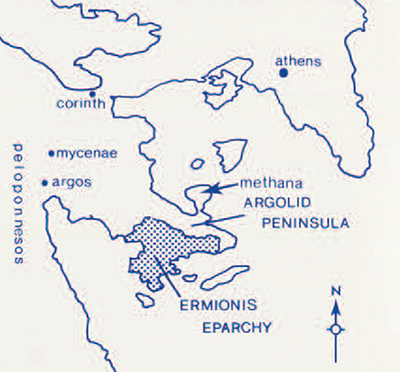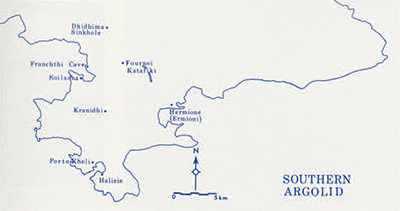 Ancient Greece, perhaps more than any other great civilization, was a culture of many small communities closely tied to the land. Most of the so-called city-states of Greece had fewer than 5000 inhabitants, and although all ancient economies were basically agricultural none was more so than that of the Creeks. Their language and thought were imbued with the metaphors of wringing a sufficiency from the land—a good marriage, for instance, was the plowing of a fertile field. The disaster the poet Hesiod (about 700 B.C.) sees threatening a community that disregards justice, or the penalty oath-takers later invoke upon themselves in case of violation, is not an eternity of damnation but the failure of nature to work—of the crops to grow, of herds to bear, of women to produce normal children. The ritual calendar of a city-state was shaped to the cycle of the agricultural year and expressed the community’s concern to maintain the cycle’s integrity.
Ancient Greece, perhaps more than any other great civilization, was a culture of many small communities closely tied to the land. Most of the so-called city-states of Greece had fewer than 5000 inhabitants, and although all ancient economies were basically agricultural none was more so than that of the Creeks. Their language and thought were imbued with the metaphors of wringing a sufficiency from the land—a good marriage, for instance, was the plowing of a fertile field. The disaster the poet Hesiod (about 700 B.C.) sees threatening a community that disregards justice, or the penalty oath-takers later invoke upon themselves in case of violation, is not an eternity of damnation but the failure of nature to work—of the crops to grow, of herds to bear, of women to produce normal children. The ritual calendar of a city-state was shaped to the cycle of the agricultural year and expressed the community’s concern to maintain the cycle’s integrity.
It was only in the 19th century that significant international and national markets developed for Greece’s agricultural products. Specialization in grapes, olives and tobacco permitted a shift from a primarily subsistence economy. Even so, it was not until after World War II that the modern world began to make its full impact felt with bull-dozed roads, mechanized pumps, cold-storage trucks to carry citrus fruit north and west into Europe. and tourism for newly-prosperous Europeans, Americans and urbanized Greeks. For the first time the urban population began to rival in size that of the countryside.
Most of the traditional means of exploiting the land and sea survive to some degree, usually altered in interesting ways. The natural environment has also changed but probably much less in terms of vegetation ant climate than is sometimes supposed. If we want to understand the basis of Greek culture in any period of history or pre-history we must begin with the countryside and the ways it has been used by the small communities of rural Greece to enable them to survive. The rural bent of Classical Greece was even more characteristic of the Bronze Age cultures that preceded it, and, of course, of the first cultivators and stock-breeders of the Neolithic period and the hunters and gatherers of Mesolithic and Palaeolithic times.
The Argolid Exploration Project began without a name in 1950 when my wife, Virginia, and I got to know the southern end of the Argolid peninsula, 70 km. across the Saronic Gulf from Athens and 40 km. down the Argolic Gulf from the far richer Argive plain with its famous Mycenaean sites. Little was known of its archaeology and history, much less its ecology and contemporary culture. There was no motor road to the rest of the Peloponnesos, so it had remained a very insular peninsula. Of its ancient past, we knew that there had been two Classical city-states, One was Hermione, the modern Ermioni, whence the administrative district (eparchy) of the Ermionis and the Anglicized geographical unit, the Hermionid. The other city-state was Halieis whose probable remains could he seen across the harbor from the fishing village of Pinto Kheli. We came hack briefly in 1954 and 1958. A chance Palaeolithic find on the way down from the highest mountain, after sharing in the herders’ annual festival to the Prophet Elijah (Profitis flies], led in 1959 to fruitless excavations in a number of small caves. Palaeolithic presence seemed clear but not the occupation of these high caves. Then in 1962, with help from the University of Pennsylvania, its University Museum and several friends, we began the excavation of Classical Halieis whose identity was quickly confirmed by local coinage found in the trenches. John Young of the Johns Hopkins University generously got us started that year and Charles Williams and I continued the excavations in 1965 and in 1966, when Charles moved to the “big city” of Ancient Corinth whose excavation he now directs year-round. Tom Jacobsen, who began his excavating career at Halieis in 1962 and went on to a field survey of the island of Euboia and more excavation on Kea, came back in 1965, and in 1967 brought in Indiana University as partner.
By this time we had completed our excavation program for the acropolis of the Classical town but our efforts to learn more about the lower town were slowed by booming land values in response to the rise of tourism and better communications. We had kept up our interest in the region as a whole and made note of everything we saw or heard. One report of interest led us to the French thi Cave, in a limestone headland across the bay from the village of Koiladha, 10 km. north of Porto Kheli. The cave was on village land, or rather rock, and our exploration of it was welcome. It was love at first sight between prehistorian and prehistoric cave, and Halieis has seen little of Tom Jacobsen since then. The Franchthi Cave’s record, unique for Greece, of continuous evidence from Upper Palaeolithic through Mesolithic and Neolithic times has been ample compensation. The Franchthi sequences provide the basis for our understanding of the area as the last Ice Age changed to Holocene conditions, and of the shift from hunting and gathering to cultivation and herding that took place between 7000 and 6000 B.C.
At Halieis meanwhile, negotiations to continue to dig on the dry land dragged on. Forced to fish in public waters, we made a virtue of necessity and began t❑ look more carefully at the edge of Porto Kheli harbor where a change in sea-level since antiquity had submerged and, in effect, excavated the northern rim of the town. The outlines of city-walls, streets, houses and a small, enclosed harbor were cleaned, measured and photographed, the last mostly by means of Julian and Eunice Whittlesey’s unmanned balloon. For the history of the environment we learned the net change in sea-level from about 350 B.C. (but not how often the sea may have risen and fallen), and we could see from the number of wells in private houses how much more plentiful fresh water had been 2300 years ago. Wood preserved in the sea mud, fruit seeds and nuts. and pollen from cores taken from the harbor bottom and compared with others from lagoons along the coast. all yielded evidence the parched land could not give. The religious center of the town, sacred to the god Apollo, was also under water, across the harbor, complete with temple, altar, auxiliary buildings and racetrack with stone-built starting lines.
After 1970 and the purchase of a limited area of the Classical town at prices fixed by a court, the dry land again began to contribute information in the excavations of Wolf Rudolph of Indiana University. We could see the origins and development of a small city-state from a little after 800 B.C. to its abandonment around 300 B.C. But this city-state was hardly a city, with perhaps 2500 inhabitants, and a state only on sufferance of its more powerful neighbors. It was but one phase of the persistent Greek phenomenon of a nuclear settlement exploiting the land within easy walking distance and the sea off its coast. To appreciate the growth of this and other city-states we needed also to see it in its regional context. That side of the Argolid Exploration Project, confined by excavation schedules to weekend outings, came to life again.

This issue of Expedition presents a few of the results of our on-going enterprise. (A number of more detailed articles by members of the project can be found in the 1976 Annals of the New York Academy of Sciences.) Hamish Forbes and Mary Clark Forbes, after a season excavating in the Franchthi Cave, settled for two years on the peninsula of Methana, on the Saronic coast of the Argolid, where traditional techniques of cultivation, and the social organization that goes with them, can be observed better than anywhere else in the region. They write respectively on tilling and on gathering, both as they have seen them practiced on Methana and as they conjecture they may have been carried on in earlier periods.
Harold and Joan Koster chose the upland village of Dhidhima for their field work. In a community where 80% of the land is regarded as fit only for grazing, herding must always be an essential part of the full exploitation of the environment. But the tending of flocks takes several forms. The proximity of the southern Argolid with its mild Mediterranean winters to the high mountains of the central Peloponnesos has permitted a pattern of transhumance—of seasonal movement of families and flocks to take advantage of the best conditions in each area. Harold twice took the “Thousand Year Road.” One would like to know for how many thousands of years this road has been traveled. Joan Koster writes of the flocks’ produce that has been particularly the concern of women, the goat’s hair and sheep’s wool. For most of history, the local flocks were the source of all that people put on their beds and bodies. Loom weights abound in our excavations and spindle whorls turn up wherever women have taken their spinning. These crafts are fast disappearing.
For both men and flocks the presence of reliable sources of water is vital. Traditionally, farming in the semi-arid regions along the western shore of the Aegean Sea and on its islands has made little use of irrigation. Intensive cultivation for a market economy has strained water resources to their limit. David Harper, who specializes in the interrelationship of systems within a region, outlines the problem in his preliminary survey.
To advance our archaeological knowledge of the region, a group in 1972, under the guidance of Tom Jacobsen and James Dengate, devoted a summer to an intensive survey using the village of Koiladha as a base. Geologists, geographers and anthropologists collaborated. The results were immensely greater in quantity and quality than many years of less systematic study had produced. David Van Horn, a member of that group, writes on one aspect of the season’s work, the light shed on Palaeolithic, Neolithic and Bronze Age technology by a study of the chipped stone.
A three-year program has been laid out to complete the archaeological surface survey of the Hermionid, and another season will be needed for the Methana peninsula. The results will help to fill in the gaps left by excavation, ethnographic study and the scanning of historical records. Eventually we hope to offer a rounded picture of how man has used this countryside since he first settled here.
